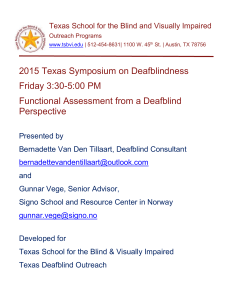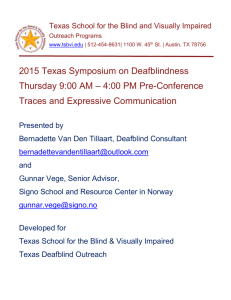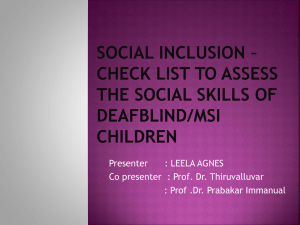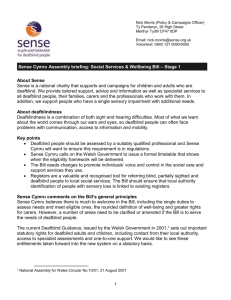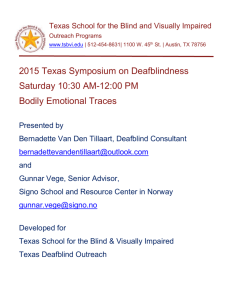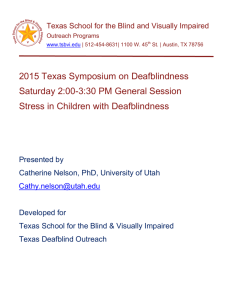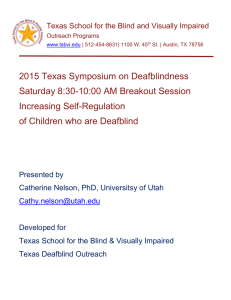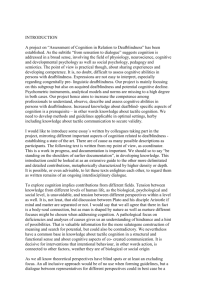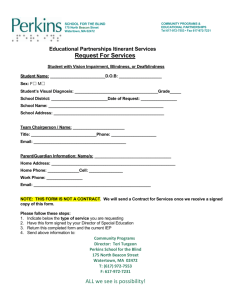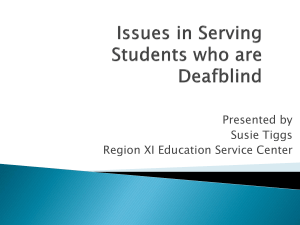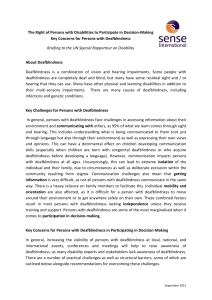Providing Access to the General Curriculum
advertisement
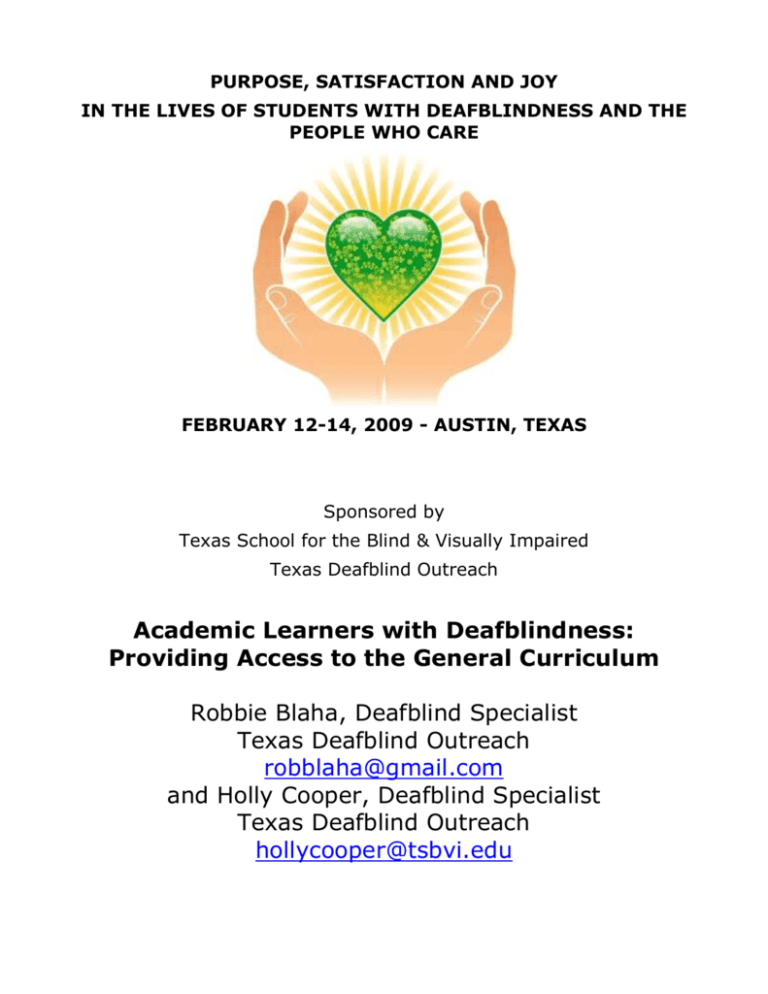
PURPOSE, SATISFACTION AND JOY IN THE LIVES OF STUDENTS WITH DEAFBLINDNESS AND THE PEOPLE WHO CARE FEBRUARY 12-14, 2009 - AUSTIN, TEXAS Sponsored by Texas School for the Blind & Visually Impaired Texas Deafblind Outreach Academic Learners with Deafblindness: Providing Access to the General Curriculum Robbie Blaha, Deafblind Specialist Texas Deafblind Outreach robblaha@gmail.com and Holly Cooper, Deafblind Specialist Texas Deafblind Outreach hollycooper@tsbvi.edu Issues in Deafblindness: When the IEP Is Aligned with the General Curriculum By Robbie Blaha, Deafblind Specialist, Texas Deafblind Outreach with help from Kate Moss, Deafblind Specialist, Texas Deafblind Outreach Abstract: Students with deafblindness who participate in the general education curriculum face some unique challenges. This article discusses these issues and proposes some strategies for addressing these concerns. Key words: Programming, deafblind, general education curriculum, intervener, concepts, IEP WHO ARE WE TALKING ABOUT? Though instruction for many students with deafblindness is focused more on life skills or functional skills, some students with deafblindness are in regular education classes or a combination of regular and resource classes. These are the students we are focusing on in this article. They are learning from the general education curriculum, and are presented the same concepts as their peers, even though they may not have the ability to deal with these concepts similarly because of the impact of their deafblindness. Even in resource classes, which typically have fewer students and curricular content at least two years below grade level, there are some important considerations for the student with deafblindness. THINGS TO CONSIDER: There are a number of considerations for students with deafblindness who are participating in the general education curriculum, even if they are working below grade level. Access to information “For a student with deafblindness, the combined effects of the vision and hearing loss create a barrier that significantly impedes the ability to gather information from the environment. This causes chronic difficulties with incidental learning and concept development. Students cannot learn what they do not detect, and they may be unaware of 2009 Texas Symposium on Deafblindness – Blaha & Cooper Academic Learners with Deafblindness: Providing Access to the General Curriculum 1 what they are missing. Access to information is a primary issue for all students with deafblindness, and should be addressed in each IEP.” (From IEP Quality Indicators for Students with Deafblindness <http://www.tsbvi.edu/Outreach/deafblind/indicators.htm>) Rate of instruction In either regular education classes or in resource classes, the typical rate of instruction can occur too rapidly for the student with deafblindness to completely process it. Additional processing time is a requirement for this student to be able to gather and interpret information. For students with normal vision and hearing, this process occurs spontaneously. Unfamiliar concepts The Texas Essential Knowledge and Skills, or TEKS, comprise the statemandated curriculum that establishes what every student, from elementary school through high school, should know and be able to do. (TEA website, 2006.) When providing instruction related to TEKS, teachers can present information that the student with deafblindness may not have the background to understand. For example, a lesson in Texas History can cover a period of time in the 1840’s when cattle drives were common through northern Texas. In order to find meaning in this lesson, the deafblind student needs to understand the concepts of an event occurring 160 years ago, that the map of Texas represents a state he lives in, the meaning of the word “drive” as it is used in cattle drive, and what the terms “cattle” and “herd” mean. He would also probably need to know why any one would want to drive cattle from one place to another. This lesson, like most that take place in general education curriculum, would progress at an alarming rate with ever more complex information being shared, and make it very difficult for the deafblind student to keep up. An additional problem occurs when the teacher clarifies new information being offered in a lesson by using what would be familiar examples for the typical students, but may not be for the student with deafblindness. For instance, the science teacher presents oxidation as 2009 Texas Symposium on Deafblindness – Blaha & Cooper Academic Learners with Deafblindness: Providing Access to the General Curriculum 2 a “chemical change brought about by exposure to oxygen” and uses rust on an old car as an example of slow oxidation. While the example helps the class better understand the new information, the student with deafblindness is unfamiliar with rusty cars. Rather than clarifying the new information, the example has just increased the amount of unfamiliar information the student has to juggle in the class. Adaptations, accommodations and/or modifications cannot completely resolve these problems The student’s IEP adaptations, accommodations and/or modifications may include large print, an FM system, frequent comprehension checks, preferential seating, reduced assignments (meaning 10 vocabulary words rather than 20) and assistance from an intervener. While all of these are critical in assisting the student to gather information, there is still a demonstrated need for the curriculum to be modified. The modification of the curricular content may involve reducing and prioritizing the information that the student is responsible for learning. The goal is for the student to have the information that provides a useful working knowledge of the curricular content. Concerns about the “other stuff” the student does not know There is ongoing evidence that the student with deafblindness is lacking a body of information that may be considered an extension of the expanded core curriculum that is taught to students with visual impairments. Basic environmental/cultural facts: Other students possess an incredible amount of knowledge about their immediate environment and teen culture that would be very useful for the student with deafblindness. The student may not know, but would benefit from knowing things like: What is a mall? Who is Lance Armstrong? What are some popular bands/songs that teens like? How do you buy a soda at school? Social skills that encourage good relationships: Many deafbind students miss out on basic social skills that other nondisabled students get incidentally. Examples of these skills include such things as: How 2009 Texas Symposium on Deafblindness – Blaha & Cooper Academic Learners with Deafblindness: Providing Access to the General Curriculum 3 do you greet people (peers, adults, strangers)? Where do you sit in the cafeteria if you want your peers to interact with you? How do you respond if a classmate tells you that she has been sick? Self advocacy skills: deafblind students need to know how to get other people’s support in gaining access to the environment and to learning. They need specific instruction in self-advocacy. Examples of these skills include things like: how do I explain to others how to use my fm system, or let the teacher know that he or she needs to turn the microphone on or off? How do I ask a peer to give me sighted-guide so I can get through the crowd at the pep rally? How do I let someone know I don’t understand the instructions on a test? WHAT CAN GO WRONG? There are many things that can happen to prevent the student with deafblindness from appropriately accessing the general education curriculum in these settings. Here are some problems we often see: The intervener is given sole responsibility for adapting the information that is being presented in the classroom. Often times he/she is left to choose and attempt to explain the information to the child as the rest of the lesson flows past. Sometimes the student ignores the teacher and the teacher ignores the student. This may happen because the teacher thinks the intervener is the only adult who is supposed to be involved with the student. At other times it may be the student who perceives the intervener as the only source of credible information. There is no real expectation that the student will learn anything of substance from the general curriculum. Unfortunately for the student with deaflbindness, some people think it is enough that the deafblind student is sitting in the classroom with typical peers. They may think it is acceptable that the deafblind student only memorizes facts and never really understands the concepts needed to finish homework or to take tests independently. The intervener or others often do most of the assignment and give the student some bits of it that he/she can do with existing skills. The student does not have time in the day to do the critical 2009 Texas Symposium on Deafblindness – Blaha & Cooper Academic Learners with Deafblindness: Providing Access to the General Curriculum 4 concept and skill development that truly brings understanding to the student and increases social skills and independence. For most students with deafblindness, additional time for this work must be provided by scheduling a study hall period or having regular time provided throughout the day for this work to be done. All too often, this extra time is not provided in the student’s schedule, so he/she is scrambling to participate in the class with the other students. The student is not participating in making sure his/her adaptations are in place. Too often a student with deafblindness finds his/herself in a learning situation without the supports he/she needs, and makes no effort to advocate for that support to be provided. The intervener or the teacher takes all the responsibility for making sure the adaptations are in place for the child. When the student becomes dependent on someone else to magically supply the adaptations he/she needs, what happens when that person is out sick? Self-advocacy skills need to be taught. Being able to ask for what you need is just as important as having that support provided to you. What should happen? To gain a useful bank of information from the Texas Essential Knowledge and Skills (TEKS), there are a variety of things that should be considered. First of all, the amount of information the child will be taught needs to be reduced by prioritizing critical concepts. Separate lesson plans need to be developed to teach underlying concepts that support learning the general curriculum. In addition, the student must have instruction in critical concepts and skills that build relationships, independence, and an understanding of the world around them. How do we make that happen? 1. Modify the general curriculum. Each regular education teacher and resource teacher should select the main points that are critical for the student to learn. 2. Select the appropriate items from the expanded core curriculum. 2009 Texas Symposium on Deafblindness – Blaha & Cooper Academic Learners with Deafblindness: Providing Access to the General Curriculum 5 The TVI, through interviews with each team member as well as discussions with and observations of the student, should guide the team in selecting the environmental information and social skills to be taught. 2009 Texas Symposium on Deafblindness – Blaha & Cooper Academic Learners with Deafblindness: Providing Access to the General Curriculum 6 3. Resolve logistical considerations. Time is provided in the student’s daily schedule for learning concepts related to the general curriculum and items from the core curriculum. The team decides which person will be responsible for providing the instruction in each setting, and also who will take on the responsibility for materials preparation. A plan is made related to accessing the community as part of instruction as it is needed. 4. The IEP is written to specify how all of the above areas will be addressed and by whom. For example, the TVI may take on responsibility for brailling all materials, but the intervener will adapt other materials under the guidance of the TVI. That needs to be spelled out so that every team member is clear about whose responsibility it is to take care of producing the materials. If the student needs additional time to work on concept development, time will need to be carved out of his/her schedule, perhaps as a study hall period. The intervener needs to know what concepts to work on with the student, and how the instructor would like to approach those concepts. If these things are left to chance, it is typically the student who suffers. Conclusion A student with deafblindness who participates in the general education curriculum, either in general education classes or resources classes, has very complex challenges in accessing the curriculum and benefiting from these programs. For the student to be successful both academically and socially, the supports provided and the content of the program need to be well orchestrated by the student’s educational team. Providing the student with an intervener may be necessary. However, the intervener needs to be part of a coordinated team effort, and not given the total responsibility for figuring out and implementing that support for the student. Providing support to the student in general education settings can be incredibly challenging, but if done well can lead to excellent outcomes for a student with deafblindness. 2009 Texas Symposium on Deafblindness – Blaha & Cooper Academic Learners with Deafblindness: Providing Access to the General Curriculum 7 References TEA website, 2006. TEKS and TAKS, http://www.tea.state.tx.us/ssc/teks_and_taas/teks_and_taas.htm 2009 Texas Symposium on Deafblindness – Blaha & Cooper Academic Learners with Deafblindness: Providing Access to the General Curriculum 8 Texas School for the Blind and Visually Impaired Outreach 1100 West 45th Street Austin, TX 78756 www.tsbvi.edu QuickTime™ and a decompressor are needed to see this picture. 2009 Texas Symposium on Deafblindness – Blaha & Cooper Academic Learners with Deafblindness: Providing Access to the General Curriculum 9
